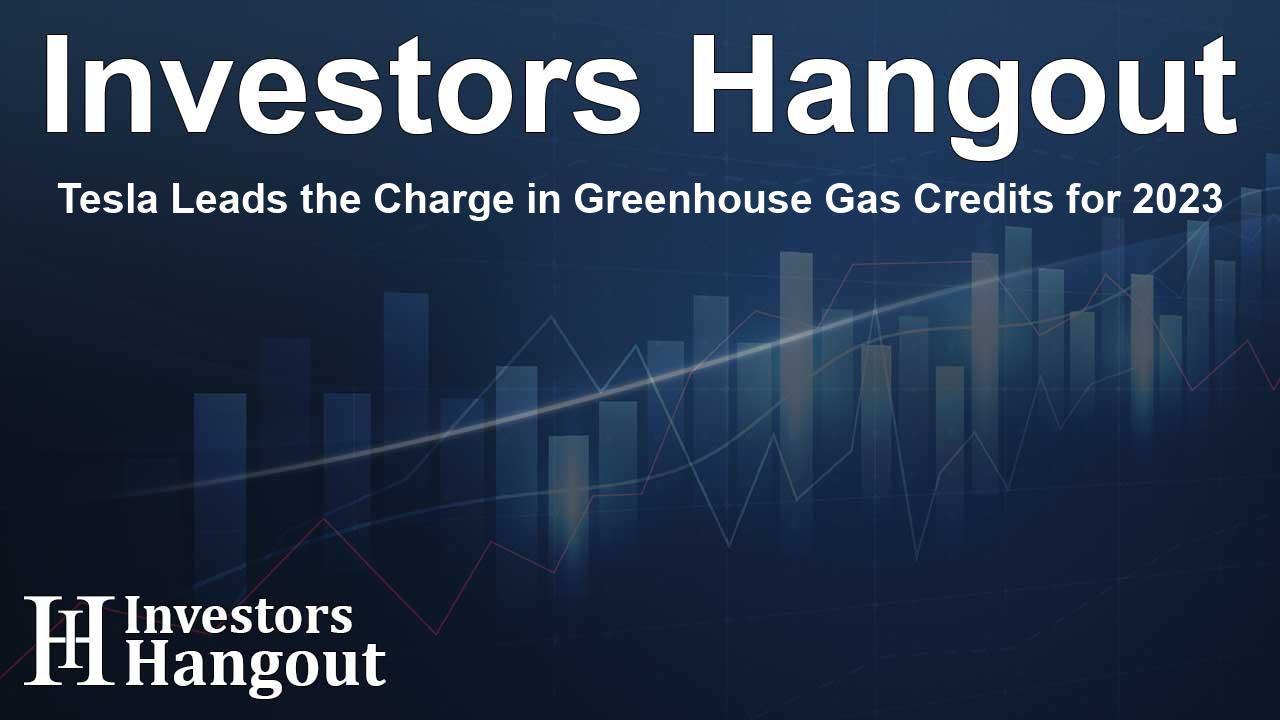Tesla Leads the Charge in Greenhouse Gas Credits for 2023

Tesla's Greenhouse Gas Credits in the 2023 Model Year
Tesla (NASDAQ: TSLA) made substantial strides in 2023 by generating nearly 34 million metric tons of greenhouse gas credits through the strong sales of electric vehicles. This has positioned Tesla significantly ahead of traditional automakers who are encountering challenges in meeting new emissions standards.
Improvements in Fuel Economy
According to a recent report by the Environmental Protection Agency (EPA), new vehicle fuel economy has achieved its highest levels ever. In 2023, vehicles improved by an average of 1.1 miles per gallon, reaching approximately 27.1 mpg (43.6 kpg). The EPA anticipates that this trend will continue, estimating that fleetwide fuel economy could further increase to 28 mpg (45.1 kpg) for the 2024 calendar year.
Deficits Across the Industry
While Tesla thrives, the automotive industry as a whole faced enormous challenges. In 2023, automakers accumulated nearly 11 million metric tons of greenhouse gas credit deficits. General Motors (NYSE: GM) was particularly affected, reporting a staggering deficit of 17.8 million metric tons. To supplement their shortfall, GM had to purchase approximately 44 million credits this past year.
The Credit Landscape
Tesla's 34 million credits sold in 2023 represent the largest credit transaction, emphasizing the company's leadership in the electric vehicle market. Without Tesla's contributions, the remaining automakers collectively incurred a massive 43.5 million credit deficit, a significant drop from the prior year's credit surplus of 3 million credits across the industry.
Future Emissions Requirements
According to the EPA, the automotive industry still holds a surplus of 123 million metric tons of credits, which provides some leeway for meeting future emissions requirements. However, significant obligations loom on the horizon. GM, for instance, faced additional setbacks as they had to forfeit 49 million metric tons of credits due to a settlement from an EPA investigation that uncovered excess emissions from their vehicles.
Changes in Regulatory Environment
The regulatory environment surrounding vehicle emissions is evolving rapidly. Recent reports suggest that the incoming administration aims to reevaluate federal regulations designed to enhance vehicle fuel efficiency and promote electric vehicle adoption. The changes proposed by the new administration could shift the focus significantly away from stringent regulatory requirements.
Tightening of Emissions Standards
In March, the EPA finalized regulations requiring car manufacturers to cut their emissions by 49% by the year 2032 compared to levels recorded in 2026. This is a notable adjustment from previous proposals, which had aimed for a 56% reduction. Such regulatory changes will compel automakers to innovate at a faster pace or risk falling behind.
Trends in Vehicle Types and Efficiency
The automotive market has also seen shifts in consumer preferences, as larger vehicles continue to dominate sales. Sedans and wagons represented only 25% of total vehicle sales in 2023, while SUVs surged to account for 58% of the market. This change reflects evolving consumer tastes and the intense competition among automakers to capture market share.
Electric Vehicle Production on the Rise
Moreover, production rates for electric and plug-in hybrid vehicles have shown promising growth, increasing from 6.7% of total production in 2022 to approximately 11.5% in 2023. The EPA believes that this percentage could reach around 14.8% in 2024, indicating a solid trend toward electrification within the industry.
Conclusion
Tesla's impressive performance in generating greenhouse gas credits positions it as a frontrunner within the automaker sphere, while other manufacturers struggle to adapt to new emissions standards. The ongoing evolution in regulations and consumer preferences will undoubtedly shape the future landscape of the automotive industry.
Frequently Asked Questions
1. What did Tesla achieve in the 2023 model year regarding greenhouse gas credits?
Tesla generated nearly 34 million metric tons of greenhouse gas credits by selling electric vehicles, leading the industry.
2. How did fuel economy change in 2023?
In 2023, average fuel economy for new vehicles increased by 1.1 miles per gallon, reaching a record high of 27.1 mpg.
3. What are the projected fuel economy figures for 2024?
The EPA projects that the fleetwide fuel economy will reach approximately 28 mpg for the 2024 model year.
4. What is the status of the automotive industry's greenhouse gas credits?
The industry collectively reported around 11 million metric tons of credit deficits in 2023.
5. How are emissions regulations affecting automakers?
New regulations require automakers to reduce emissions by 49% by 2032, putting pressure on them to innovate and meet stricter standards.
About Investors Hangout
Investors Hangout is a leading online stock forum for financial discussion and learning, offering a wide range of free tools and resources. It draws in traders of all levels, who exchange market knowledge, investigate trading tactics, and keep an eye on industry developments in real time. Featuring financial articles, stock message boards, quotes, charts, company profiles, and live news updates. Through cooperative learning and a wealth of informational resources, it helps users from novices creating their first portfolios to experts honing their techniques. Join Investors Hangout today: https://investorshangout.com/
Disclaimer: The content of this article is solely for general informational purposes only; it does not represent legal, financial, or investment advice. Investors Hangout does not offer financial advice; the author is not a licensed financial advisor. Consult a qualified advisor before making any financial or investment decisions based on this article. The author's interpretation of publicly available data shapes the opinions presented here; as a result, they should not be taken as advice to purchase, sell, or hold any securities mentioned or any other investments. The author does not guarantee the accuracy, completeness, or timeliness of any material, providing it "as is." Information and market conditions may change; past performance is not indicative of future outcomes. If any of the material offered here is inaccurate, please contact us for corrections.